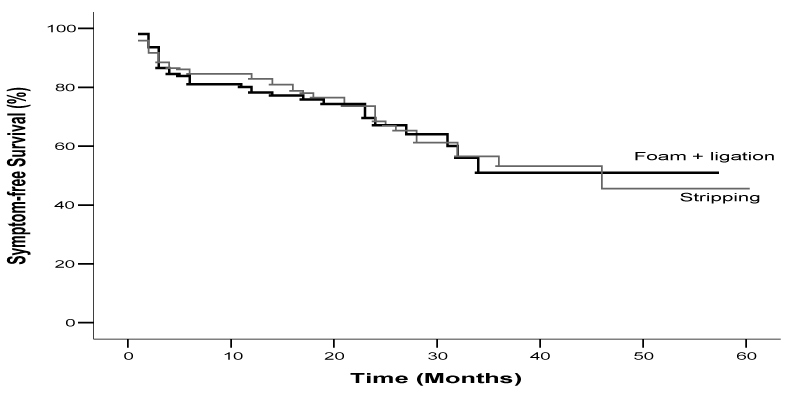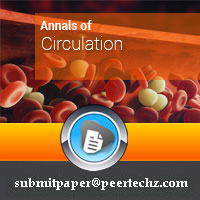Annals of Circulation
Varicose vein surgery versus foam sclereotherapy to prevent extension of venous reflux with time
Fatih Islamoglu*
Cite this as
Islamoglu F (2020) Varicose vein surgery versus foam sclereotherapy to prevent extension of venous reflux with time. Ann Circ 5(1): 008-010. DOI: 10.17352/ac.000016Background and aim
In the treatment of Chronic Venous Insufficiency (CVI) High Ligation (HL) and stripping of the saphenous varicose veins, and percutaneous phlebectomy have been the main options for many years. Modern management of CVI includes treatment of the cause (reflux) and result (varicose veins). Reflux should be treated before varicosities because if the cause is not eliminated, the varicose veins will recur [1]. Generally, the elimination of reflux has been accomplished with surgery. The new thermal ablation techniques such as Endovenous Laser Ablation Ttherapy (EVLT) and Radiofrequency (RF) ablation have the advantage of being performed with only local anesthesia, but they have the potential for residual saphenofemoral reflux due to incomplete ablation of all side branches of the Saphenofemoral Junction (SFJ) [1]. These techniques can obliterate only the main trunk of the saphenous vein, and complete disconnection of all of the side branches draining to the SFJ is never accomplished. Classical surgical HL has also been shown to lead to recurrent varicose vein development due to neovascularization, but this is not completely true; real neovascularization demonstrated by Doppler is rare and is mostly related to the SFJ and side branches not being divided properly. Thus, the primary cause of varicose vein recurrence after surgery is inadequate surgical technique, and neovascularization is never the only cause of recurrence [2]. It also has an incidence of 7.1% after EVLT and 2.2% after RF ablation. The development of arteriovenous fistulae and the intensity of the inflammatory response might be responsible for recanalization of ablated venous segments. This effect is due entirely to inadequate SFJ or side branch division in the initial procedure [1,2]. In support of the importance of complete SFJ ligation, small vessel networks and GSV recanalization at the SFJ have more commonly been found in patients undergoing RF ablation without ligation (46%) than RF ablation with ligation (14%) [3]. In a systematic review comparing recurrence rates, overall complication rates, and symptom relief, it was found that surgery was not inferior to endovenous procedures. Our past experience and results of previous studies comparing the results of three different surgical techniques (complete stripping with HL, partial above-knee stripping with HL, and HL alone) have shown that the best recurrence rate, best improvement in CEAP class, and best event-free survival rates are achieved using complete stripping with HL [4]. The rate of residual reflux and recurrence after partial stripping can reach up to 20%, and this complication is found more often with patent belowknee saphenous veins than with Incompetent Perforatory Veins (IPVs) undetected preoperatively. Given that these techniques are theoretically equivalent to stripping with low ligation of the proximal saphenous vein, it is not wise or completely true to claim that their recurrence rates and effectiveness are better than those of complete stripping with HL. Past experiments have shown that, for HL with complete division of the SFJ and all side branches, full-length obliteration of the saphenous vein for insufficiency was necessary to prevent recurrence [4].
An incompetent SFJ, an incompetent SSV, IPVs, an incompetent superficial vessel in the thigh, HL without stripping, female sex, and post-thrombotic DVI were all associated with greater risk of recurrence after a technically correct surgery [5]. Our study on 372 patients showed that preoperative CEAP class, bilateral limb disease, occupation, family history or genetic predisposition, prior DVT (post-thrombotic etiology of varices), older age, and preoperative IPVs were predictors of early postoperative and later clinical status, outcome, and other events. The predictors of postoperative symptom recurrence and clinical and Doppler examination findings depend mostly on the preoperative characteristics of individual patients and varicose vein surgery can prevent extension of venous reflux with 5-year symptom-free survival rate of 51±0.8% [6].
Method
We continued to recruit patients till today fot this study and now it included 2986 and 4224 patients who had undergone classic stripping and foam sclerotherapy, respectively, within the previous 12 years (May 2005-May 2019). The study complied with ethical principles of the Helsinki Decleration for Medical Research Involving Human Subjects. Research ethics board at our instution approval was obtained. Preoperative and postoperative CEAP class, symptoms, recurrence, quality of life scores (venous class severity score-VCSS and Aberdeen varicose vein quoestionnaire score-AVVQ) and Doppler findings of the two groups were compared in 7210 patients, who had undergone either HL+strippping or HL+foam, Stripping group included 42% patients, foam+ligation group included 58% patients. The technique of operation has no significant effect on postoperative symptom recurrence, CEAP class, and doppler findings.
Statistical methods
Statistical analyses were performed using SPSS/PC+ software (ver. 17.0). P-values of less than 0.05 were considered significant. The frequency and percentage values of categorical variables and the mean, average and standard deviation values of continuous variables were determined. Patient characteristics and hospital outcomes were compared using a t-test for continuous variables and Chi-square or Fisher exact tests for categorical variables. Patients were classified as having a particular variable or not. Differences between preoperative and postoperative symptom status were compared using linear trend analyses. Event-free survival was evaluated by Kaplan-Meier analysis. Correlates of event-free survival and risk factors affecting postoperative symptom development were analyzed using a Cox proportional hazards model and multivariate stepwise logistic regression analyses.
Results
There is no significant difference on postoperative effectivity between foam sclerotherapy and stripping (Figures 1,2). There is no significant difference on VCSS and AVVQ between two techniques (Table 1).
Discussion
Relative to other endovascular techniques such as laser and RF ablation, the use of foam sclerotherapy is significantly more cost effective. There is no significant difference in clinical important outcomes between ultrasound-guided foam sclerotherapy and endothermal ablation. As ultrasound-guided foam sclerotherapy is less expensive, it is likely to be a more cost-effective option in most patients in most healthcare settings [7]. Besides the ease of application, less postoperative discomfort and more patient satisfaction, a recent prospective study showed that although standard stripping of the GSV and invagination stripping were not associated with major discomfort and problems in the early postoperative period, SFJ ligation and GSV reverse foam sclerotherapy yielded better patient satisfaction with less postoperative brusising and discomfort and reduced analgesic requirements [8,9]. The safety and effectivity of ligation + foam sclerotherapy as an alternative technique making possible daily surgery are not different than those of classic stripping. The predictors of postoperative symptom recurrence and clinical and Doppler examination findings depend mostly on the preoperative characteristics of individual patients and both varicose vein surgery and foam sclerotherapy with HL can prevent extension of venous reflux with time.
- Merchant R, Pichot O (2005) Long term outcomes of endovenous radiofrequency obliteration of saphenous reflux as a treatment for superficial venous insufficiency. J Vasc Surg 42: 502-509. Link: http://bit.ly/39Vpx5G
- Labropoulos N, Bhatti A, Leon L (2006) Neovascularization after great saphenous vein ablation. Eur J Vasc Endovasc Surg 31: 219-222. Link: http://bit.ly/32ksf2a
- Salles-Cunha SX, Comerota AJ, Tzilinis A (2004) Ultrasound findings after radiofrequency ablation of the great saphenous vein.descriptive analysis. J Vasc Surg 40: 1166-1173. Link: http://bit.ly/32mcsQj
- Dwerryhouse S, Davies B, Harradine K, Earnshaw JJ (1999) Stripping the long saphenous vein reduces the rate of reoperation for recurrent varicose veins: five-year results of a randomized trial. J Vasc Surg 29: 589-592. Link: http://bit.ly/2vYRPxK
- Allegra C, Antignani PL, Carlizza A (2007) Recurrent vari cose veins following surgical treatment: our experience with five years follow-up. Eur J Vasc Endovasc Surg 33: 751-756. Link: http://bit.ly/2PlEA0L
- Islamoglu F (2011) An alternative treatment for varicose veins: ligation plus foam sclerotherapy. Dermatol Surg 37: 470-479. Link: http://bit.ly/39WWwGX
- Tan VKM, Tan SG (2009) Technique and early results of ultrasound-guided foam sclerotherapy of the long saphenous vein for treatment of varicose veins. Singapore Med J 50: 284-287. Link: http://bit.ly/32nmb9l
- Abela R, Liamis A, Prionidis L (2008) Reverse foam sclerotherapy of the great saphenous vein with sapheno-femoral ligation compared to standard and invagination stripping: A prospective clinical series. Eur J Vasc Endovasc Surg 36: 485-490. Link: http://bit.ly/37SmpGC
- Islamoglu F (2018) Can foam sclerotherapy with high ligation prevent extension of venous reflux with time. Ann Vasc Med 5: 1097.
Article Alerts
Subscribe to our articles alerts and stay tuned.
 This work is licensed under a Creative Commons Attribution 4.0 International License.
This work is licensed under a Creative Commons Attribution 4.0 International License.



 Save to Mendeley
Save to Mendeley
